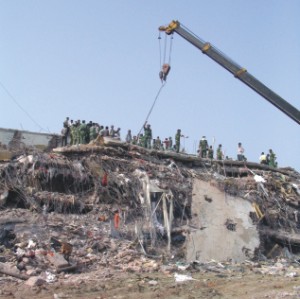 |
Tilting dangerously: The seven-storey structure at Kathalbagan. |
People are rushing to gape at the tower that has tilted towards another building in a residential area. One crack in its ground floor led the seven-storey structure to literally lean against another 17-storey newly built structure in city's Kathalbagan area early this month. The leaning tower also slid into the ground making its ground floor go completely underground. Fortunately this time the incident did not end in tragedy.
The incident is not the first of its kind; the capital has already witnessed such disaster whereas a number of structures collapsed due to faulty construction and other mismanagement. A five-storey building collapsed over a tin-shed structure three months ago in the city's Begunbari area taking 25 lives and after a week's pause another six-storey building leaned to one side in the same area. In 2005, Spectrum Garments in Savar and in 2006 Phoenix building in city's Tejgaon had collapsed for the same reasons.
Rajdhani Unnayan Kartripakkha (Rajuk) chairman Md Nurul Huda says, such building collapses are occurring due to improper construction designs and violation of building codes while constructing any structure. At this moment there are around 5,000 structures standing in the city with faulty designs and Rajuk has vowed to demolish them partially or fully on the basis of the intensity of the problem. Besides faulty design, there are also structures that are built without any sort of approval from Rajuk and the organisation is carrying out a survey to find out the total number of unapproved structures, says Huda.
If any structure is to be constructed, the builder has to take approval from Rajuk. Huda explains that Rajuk approves the project only if the plan has the signature of the architect, soil engineer, design engineer and the construction engineer involved with the project. “These experts okay the project at four different levels and if the builders follow the officially authorised procedures any construction would be an appropriate one. And if two other components- following Building Construction Rules and Bangladesh National Building Code- is added to it, the risk of such accident becomes nil,” observes Huda.
“Yet, violation occurs, exploiting the loopholes of the law, using fake signatures or taking advantage of a few corrupt people, these faulty designs get approved. Again, there are some who get the required approval from Rajuk showing an appropriate plan of the project, but hardly following that plan and thus violation prevails,” adds Huda marking this as a root cause for the problem.
In this particular case of Pukurpar, Kathalbagan, Rajuk served deviation notice to Asia Comtech Bangladesh, the builder of Asia Haider Tower about a year ago and did not get any response from their end. The very building required 65 feet piling into the ground but, according to the experts, the building had either no piling or hardly 25 feet piling into the ground. Again, it was supposed to be constructed 25 feet away form the next building standing beside it, but violating this requirement it was constructed so close to the next one.
 |
Lack of good governance in the whole process of urbanisation and infrastructure development of the city are the causes of such frequent building collapse. Photo: zahedul i khan |
“Rajuk cannot monitor each violation in every construction as we have limited manpower to deal with all the problems. Currently we have 1087 posts in this organisation, of them 200 posts are vacant. A proposal has been placed asking for 2,742 employees for the organisation who will work at different levels,” says Huda.
Among the 3,26,000 structures in the main land of the city 239 are marked as heritage sites, 321 as 'most vulnerable' structures, and Rajuk is working to preserve or demolish the structures according to requirement, continues Huda.
Huda also narrates the preventive measures they are taking to stop the construction of unapproved buildings by having meetings with service organisations (like DESA, DESCO, Titas Gas, WASA) and asking them not to provide services to the structures that have been built without Rajuk approval. “And Rajuk will not approve any structures without compliance with the Detailed Area Plan (DAP) from now on” adds Huda.
Noted urban researcher Prof Nazrul Islam blamed lack of good governance in the whole process of urbanisation and infrastructure development of the city as the cause of such frequent building collapse. “Rajuk, as the responsible regulating body in this regard has to be more strict to stop Dhaka from becoming the most unplanned city and getting declared as an abandoned city soon” observes Islam.
“The Government has also the responsibility to provide Rajuk with the essential logistical support to conduct its survey, monitoring operations and so on,” he adds. Rajuk has identified 5000 structures in the city as faulty, but the obligation is not over identifying only, the whole issue needs to be addressed immediately, otherwise we might have to witness more destruction and death.
Individuals who are involved with the construction (engineer and architects) that is faulty and that results in accidents have to be punished. The organisations that are responsible for the carrying out monitoring and assessments of constructions have to be held accountable and must adopt strict measures. The price of lax enforcement of regulations and the greed of unscrupulous developers is the avoidable deaths of innocent residents.
